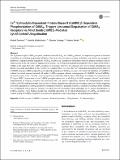| dc.contributor.author | Zemoura, Khaled | |
| dc.contributor.author | Balakrishnan, Karthik | |
| dc.contributor.author | Grampp, Thomas | |
| dc.contributor.author | Benke, Dietmar | |
| dc.date.accessioned | 2018-06-13T19:34:36Z | |
| dc.date.available | 2018-06-13T19:34:36Z | |
| dc.date.issued | 2018-06 | |
| dc.date.submitted | 2018-01 | |
| dc.identifier.issn | 0893-7648 | |
| dc.identifier.issn | 1559-1182 | |
| dc.identifier.uri | http://hdl.handle.net/1721.1/116293 | |
| dc.description.abstract | The G protein-coupled GABAB receptors, constituted from GABAB1 and GABAB2 subunits, are important regulators of neuronal excitability by mediating long-lasting inhibition. One factor that determines receptor availability and thereby the strength of inhibition is regulated protein degradation. GABAB receptors are constitutively internalized from the plasma membrane and are either recycled to the cell surface or degraded in lysosomes. Lys-63-linked ubiquitination mediated by the E3 ligase Mind bomb-2 (MIB2) is the signal that sorts GABAB receptors to lysosomes. However, it is unknown how Lys-63-linked ubiquitination and thereby lysosomal degradation of the receptors is regulated. Here, we show that Ca2+/calmodulin-dependent protein kinase II (CaMKII) promotes MIB2-mediated Lys-63-linked ubiquitination of GABAB receptors. We found that inhibition of CaMKII in cultured rat cortical neurons increased cell surface GABAB receptors, whereas overexpression of CaMKIIβ, but not CaMKIIα, decreased receptor levels. This effect was conveyed by Lys-63-linked ubiquitination of GABAB1 at multiple sites mediated by the E3 ligase MIB2. Inactivation of the CaMKII phosphorylation site on GABAB1(Ser-867) strongly reduced Lys-63-linked ubiquitination of GABAB receptors and increased their cell surface expression, whereas the phosphomimetic mutant GABAB1(S867D) exhibited strongly increased Lys-63-linked ubiquitination and reduced cell surface expression. Finally, triggering lysosomal degradation of GABAB receptors by sustained activation of glutamate receptors, a condition occurring in brain ischemia, was accompanied with a massive increase of GABAB1(Ser-867) phosphorylation-dependent Lys-63-linked ubiquitination of GABAB receptors. These findings indicate that CaMKIIβ-dependent Lys-63-linked ubiquitination of GABAB1 at multiple sites controls sorting of GABAB receptors to lysosomes for degradation under physiological and pathological condition. | en_US |
| dc.publisher | Springer US | en_US |
| dc.relation.isversionof | https://doi.org/10.1007/s12035-018-1142-5 | en_US |
| dc.rights | Creative Commons Attribution | en_US |
| dc.rights.uri | http://creativecommons.org/licenses/by/4.0/ | en_US |
| dc.source | Springer US | en_US |
| dc.title | Ca²⁺/Calmodulin-Dependent Protein Kinase II (CaMKII) β-Dependent Phosphorylation of GABAB1 Triggers Lysosomal Degradation of GABAB Receptors via Mind Bomb-2 (MIB2)-Mediated Lys-63-Linked Ubiquitination | en_US |
| dc.type | Article | en_US |
| dc.identifier.citation | Zemoura, Khaled et al. “Ca²⁺/Calmodulin-Dependent Protein Kinase II (CaMKII) β-Dependent Phosphorylation of GABAB1 Triggers Lysosomal Degradation of GABAB Receptors via Mind Bomb-2 (MIB2)-Mediated Lys-63-Linked Ubiquitination.” Molecular Neurobiology (June 2018): 1-17 © 2018 The Author(s) | en_US |
| dc.contributor.department | Picower Institute for Learning and Memory | en_US |
| dc.contributor.mitauthor | Zemoura, Khaled | |
| dc.relation.journal | Molecular Neurobiology | en_US |
| dc.eprint.version | Final published version | en_US |
| dc.type.uri | http://purl.org/eprint/type/JournalArticle | en_US |
| eprint.status | http://purl.org/eprint/status/PeerReviewed | en_US |
| dc.date.updated | 2018-06-08T03:54:16Z | |
| dc.language.rfc3066 | en | |
| dc.rights.holder | The Author(s) | |
| dspace.orderedauthors | Zemoura, Khaled; Balakrishnan, Karthik; Grampp, Thomas; Benke, Dietmar | en_US |
| dspace.embargo.terms | N | en_US |
| mit.license | PUBLISHER_CC | en_US |

